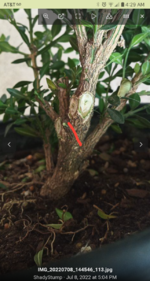p_anova
Mame
Kingsville?Why wouldn't I? If it bounces back from this it should be alright by April, May I would think.
Kingsville?Why wouldn't I? If it bounces back from this it should be alright by April, May I would think.
Green gem boxwood is what's on the tag. I haven't researched the specific cultivar yet. Actually working on that now.Kingsville?

I actually considered that exact cut. In the moment it didn't feel like it would fit the story I was working with.I was happiest when this was still an option.
View attachment 446087
Growing from "scratch" is easier than growing from "scratched"?
I feel a hesitation to remove large pieces of slower growing trees may fool us into a longer, more difficult future, because it seems the opposite.
From this now impossible proposed red cut, you are merely allowing the tree to grow whilst removing unnecessary pieces.
From your current state, you have to control what is there while hoping other stuff grows to match it. This bit of backwards work is what makes the timeline longer.
I haven't seen a boxwood, where cutting to below the first bulge entirely, to the lowest near alternate old growth, doesn't make for the best possible tree.
Keep an eye out for that.
I reckon sketching future trees from both beginnings can best aide this understanding.
Sorce
I've been experimenting and learning on some of my ficus benjamina, and realized that wiring a branch that I'm likely to cut back in the future can amount to wasted effort and wire sometimes. Use weight and guy wires to set the general direction, then coil wiring later on to as part of more detailed development.The problem with weights and guy wires is they're more likely to produce rainbow arches at the crotch of the branch. I can see with guy wires possibly overcoming it, but if you're going to go to that degree, seems like the time would be better spent applying proper sized coiled wire. (Also, seems the elasticity of boxwood would make weights/guy wires doubly (or more?) troublesome.)
I added 3 wires (and one guy wire) to a chuhin boxwood last evening and the complexity of the branching it revealed was surprising to me.
not complete heal, just callus bridgingAh. But don't remove it, and let it heal in the new position?
Okay ficus is different... on shohin size development you will not get a snap.I've been experimenting and learning on some of my ficus benjamina, and realized that wiring a branch that I'm likely to cut back in the future can amount to wasted effort and wire sometimes. Use weight and guy wires to set the general direction, then coil wiring later on to as part of more detailed development.
I think sometimes people just assume they have to do a bunch of wiring to get anything, and it does help you feel like you're looking at a more finished tree when you wire everything and put it all in position.
That said, I am looking at a tree from where I sit that I'll have little other choice than to wire if I'm ever going to get that one branch moving in the right direction.
You have to do whatever the situation calls for.
I actually considered that exact cut. In the moment it didn't feel like it would fit the story I was working with.
Your are right, now that it's pointed out, that I have some work to do in grasping the "find the smallest tree" concept.
I've heard all of that about boxwood. This green gem is supposed to be extra hardy to the cold, which will be helpful.I have a harlandi boxwood and it's very difficult to shape with wire or anything else. It just wants to assume it's original shape.
I looked it up and yours is a 'buxus hybrid' which may make it easier to shape with wire or weight. Good luck with it. Hope it's an easy one to work with. Mine is bulletproof in all other respects. An easy keep.
